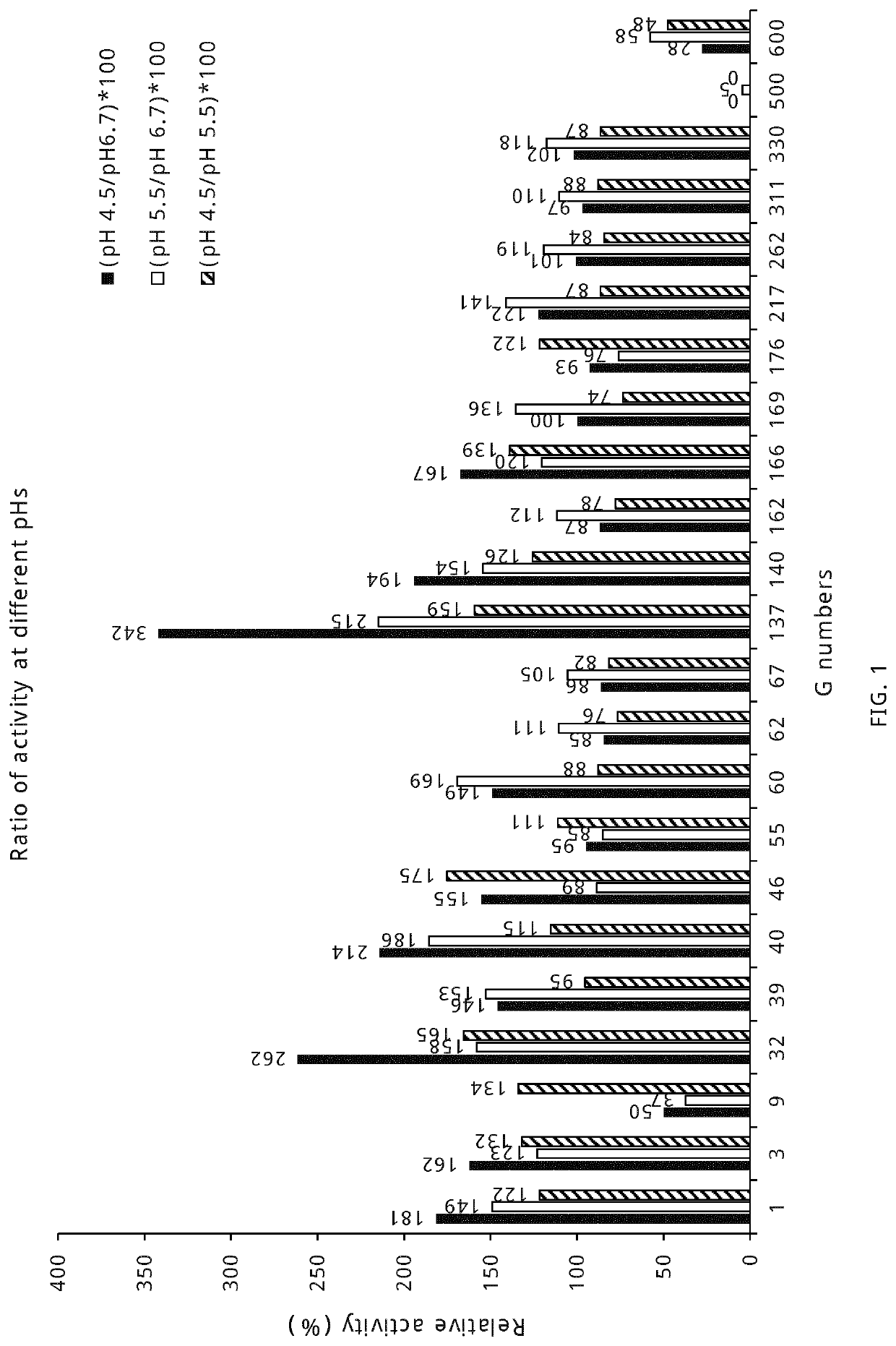Lactase enzymes with improved properties at acidic ph
a technology of acidic ph and lactase enzyme, which is applied in the field of improved peptides or dimeric peptides exhibiting betagalactosidase enzymes, to achieve the effects of reducing lactose content, reducing and reducing the amount of lactose in a produ
- Summary
- Abstract
- Description
- Claims
- Application Information
AI Technical Summary
Benefits of technology
Problems solved by technology
Method used
Image
Examples
example 1
ion of the Expression Vector for the Production of Lactases
[0078]The genomic DNA of the lactic acid bacteria or bifidobacteria was extracted using commercial genomic extraction kit by following the supplied protocol (DNeasy, Qaigen, Germany). The lactase gene was amplified by PCR using two synthetic primers, using the purified genomic DNA source as biomass, and the PCR reagents were supplied in the Phusion U Hot start DNA polymerase (Thermo Scientific, USA) kit. The lactase gene was cloned into the start codon of the expression vector pBAD / His using the USER cloning method (Nour-Eldin HH, Geu-Flores F, Halkier BA, Plant Secondary Metabolism Engineering, Methods in Molecular Biology, 643; 2010), resulting in the expression construct. With the USER cloning method long complementary overhangs in both PCR product and destination vector were generated. These overhangs can anneal to each other to form a stable hybridization product which was used to transform into E. coli without ligation...
example 3
Determination Using Enzymes on Lactose as Substrate at pH 6.7 at 37° C.
[0080]To measure the beta-galactosidase activity, the lactases were diluted to 40× in buffer A (50 mM NaH2PO4 buffer pH 6.7 containing 100 μM of MgSO4). In a separate reaction, the diluted enzyme was incubated with lactose solution prepared in buffer B (140 mM of lactose prepared in 100 mM sodium-citrate buffer of pH 6.7, containing 100 μM of MgSO4). The reaction mixture was prepared by mixing 13 μL of diluted enzyme and 37 μL of lactose solution in a PCR tube. The reaction mixture was incubated in a DNA thermal cycler with the following incubation parameters (reaction time; 10 min at 37° C., enzyme inactivation; 10 min at 95° C., cooling; 4° C.). The reaction mixtures were stored at −20° C. until further use. To determine the amount of glucose formed during the reaction, 10 μL of the reaction mixture was transferred to one well of standard microtiter plate (Thermo Fischer Scientific, Denmark) containing 80 μL of...
example 4
Determination Using Enzymes on Lactose as Substrate at pH 5.5 at 37° C.
[0081]The lactases were diluted up to 40× in buffer A (50 mM NaH2PO4 buffer pH 6.7 containing 100 μM of MgSO4). In a separate reaction, the diluted enzyme was incubated with lactose solution prepared in buffer E (140 mM of lactose prepared in 100 mM sodium-citrate buffer of pH 5.5, containing 100 μM of MgSO4). The reaction mixture was prepared by mixing 13 μL of diluted enzyme and 37 μL of lactose solution in a PCR tube. The reaction mixture was incubated in a DNA thermal cycler using the following incubating parameters (reaction time; 10 min at 37° C., enzyme inactivation; 10 min at 95° C., storage; 4° C.). The reaction mixtures were stored at −20° C. until further use. The maximum absorbance value for each lactase was used to determine μmol of glucose formed per minute, described as 1 Unit of Activity with Lactose at pH 5.5 at 37° C. The maximum absorbance value for each lactase was used to determine μmol of gl...
PUM
| Property | Measurement | Unit |
|---|---|---|
| pH | aaaaa | aaaaa |
| pH | aaaaa | aaaaa |
| pH | aaaaa | aaaaa |
Abstract
Description
Claims
Application Information
 Login to View More
Login to View More - R&D Engineer
- R&D Manager
- IP Professional
- Industry Leading Data Capabilities
- Powerful AI technology
- Patent DNA Extraction
Browse by: Latest US Patents, China's latest patents, Technical Efficacy Thesaurus, Application Domain, Technology Topic, Popular Technical Reports.
© 2024 PatSnap. All rights reserved.Legal|Privacy policy|Modern Slavery Act Transparency Statement|Sitemap|About US| Contact US: help@patsnap.com








